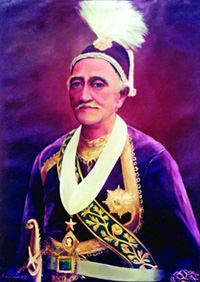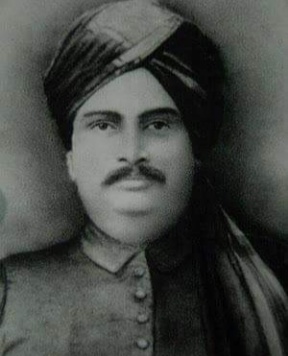
A zamindar in the Indian subcontinent was an autonomous or semi-autonomous ruler of a province. The term itself came into use during the reign of Mughals and later the British had begun using it as a native synonym for "estate". The term means landowner in Persian. They were typically hereditary, and held the right to collect tax on behalf of imperial courts or for military purposes.

Murshidabad is a historical city in the Indian state of West Bengal. It is located on the eastern bank of the Bhagirathi River, a distributary of the Ganges. It forms part of the Murshidabad district.

The Nawab of Bengal was the hereditary ruler of Bengal Subah in Mughal India. In the early 18th-century, the Nawab of Bengal was the de facto independent ruler of the three regions of Bengal, Bihar and Orissa which constitute the modern-day sovereign country of Bangladesh and the Indian states of West Bengal, Bihar and Odisha. They are often referred to as the Nawab of Bengal, Bihar and Orissa. The Nawabs were based in Murshidabad which was centrally located within Bengal, Bihar, and Odisha. Their chief, a former prime minister, became the first Nawab. The Nawabs continued to issue coins in the name of the Mughal Emperor, but for all practical purposes, the Nawabs governed as independent monarchs. Bengal continued to contribute the largest share of funds to the imperial treasury in Delhi. The Nawabs, backed by bankers such as the Jagat Seth, became the financial backbone of the Mughal court. During the 18th century, the Nawabs of Bengal were among the wealthiest rulers in the world.

Nawab Bahadur Sir Khwaja Abdul Ghani was the second Nawab of Dhaka and the first to assume the title of Nawab as hereditary, recognized by the British Raj.

The Nawab of Dhaka, originally spelt in English Nawab of Dacca, was the title of the head of largest Muslim zamindar in British Bengal and Assam, based in present-day Dhaka, Bangladesh. The title of nawab, similar to the British peerage, was conferred upon the head of the family by Queen Victoria as a recognition of the first Nawab's loyalty and contribution to the social welfare activities.

Kulaura is the biggest upazila (subdistrict) of the Moulvibazar District in north-eastern Bangladesh. The total area of this upazila is 545 km2. Hakaluki Haor, the largest marsh wetland in Sylhet and one of the largest in Bangladesh is partially located there.

The Imperial Legislative Council (ILC) was the legislature of British India from 1861 to 1947. It was established under the Charter Act of 1853 by providing for the addition of 6 additional members to the Governor General Council for legislative purposes. Thus, the act separated the legislative and executive functions of the council and it was this body within the Governor General's Council which came to known as the Indian/Central Legislative Council. In 1861 it was renamed as Imperial Legislative Council and the strength was increased.
The Singranatore family is the consanguineous name given to a noble family in Rajshahi of landed aristocracy in erstwhile East Bengal and West Bengal that were prominent in the nineteenth century till the fall of the monarchy in India by Royal Assent in 1947 and subsequently abolished by the newly formed democratic Government of East Pakistan in 1950 by the State Acquisition Act.

Sarfarāz Khān, born Mīrza Asadullāh, was a Nawab of Bengal. Sarfaraz Khan's maternal grandfather, Nawab Murshid Quli Khan of Bengal nominated him as the direct heir to him as there was no direct heir. After Murshid Quli's death in 1727, Sarfaraz ascended to the Masnad (throne) of the Nawab. Sarfaraz's father, Shuja-ud-Din Muhammad Khan, then the Subahdar of Orissa, getting to know it arrived at Murshidabad, the capital of the Nawabs of Bengal with a huge army. To avoid a conflict in the family the dowager Begum of the Nawab asked Shuja-ud-Din to ascend to the Masnad after Sarfaraz abdicated in favour of his father. However, circumstances led Shuja-ud-Din to nominate Sarfaraz as his heir and after Shuja-us-Din's death in 1739, Sarfaraz Khan again ascended to the Masnad as the Nawab of Bengal.

Shuja-ud-Din Muhammad Khan was the Nawab of Bengal. He married Zainab un-nisa Begum and Azmat un-nisa Begum, the daughters of Murshid Quli Khan by Nasiri Banu Begum. Shuja-ud-Din's third wife was Durdana Begum Sahiba. After the death of his father-in-law on 30 June 1727, he ascended to the Masnad (throne) of the Nawab.
The Maratha invasions of Bengal (1741–1751), also known as the Maratha expeditions in Bengal, were the frequent invasions by the Maratha forces in the Bengal Subah, after their successful campaign in the Carnatic region at the Battle of Trichinopoly. The leader of the expedition was Maratha Maharaja Raghoji Bhonsle of Nagpur. The Marathas invaded Bengal five times from August 1741 to May 1751, which caused widespread economic losses in the Bengal Subah.

The Prithimpassa family, also known as the Nawabs of Longla, are an Shia royal family from the Prithimpassa Union, Kulaura Upazila, Moulvibazar, Sylhet, Bangladesh. The family was of the erstwhile feudal nobility of East Bengal. They played important roles in the Indian Rebellion of 1857, the Partition of India and Sylhet referendum in 1947, and the Bangladesh Liberation War of 1971.

The East Bengal State Acquisition and Tenancy Act of 1950 was a law passed by the newly formed democratic Government of East Bengal in the Dominion of Pakistan. The bill was drafted on 31 March 1948 during the early years of Pakistan and passed on 16 May 1951. Before passage of the legislature, landed revenue laws of Bengal consisted of the Permanent Settlement Regulations of 1793 and the Bengal Tenancy Act of 1885.

The Zamindars of Bengal were zamindars of the Bengal region of the Indian subcontinent. They governed an ancient system of land ownership.

Zamindars of Natore were influential aristocratic Bengali Zamindars, who owned large estates in what is today Natore District in Bangladesh .

The Nawabs of Dhanbari, also known as the Chowdhury family of Dhanbari, were a Bengali aristocratic family of feudal landowners. The zamindari estate encompassed parts of the Tangali, Jamalpur, Mymensingh and Pabna District, particularly around Dhanbari. Although their aristocratic status was lost with the East Bengal State Acquisition and Tenancy Act of 1950, the Dhanbari estate remains an important part of the history of Tangail and tourist attraction.

The Murho Estate was a Chieftaincy and later a Zamindari (estate) of Yadav (Ahir) in erstwhile Bhagalpur district of Bihar.

Raja Rash Bihari Lal Mandal (1866-1918) was a zamindar, philanthropist and a leader of Indian Independence Movement. He wrote a book named 'Bharat Mata Ka Sandesh' during Bang Bhang movement.

The Gunahar Zamindar Bari was a zamindari estate based in the Bogra District of Bangladesh. The residential palace, popularly known as Saheb Bari, was the erstwhile Zamindars of Gunahar in Dhupchanchia. The present building was constructed in 1941, and remains a tourist attraction.

Patkum estate was one of the zamindari estates of India during the period of the British Raj. It is believed that the estate was found by scion of the King Vikramaditya of Solar dynasty. During British raj it was part of Bengal presidency, composing todays Chandil, Kukru, Nimdih, Ichagarh and Kandra. Ichagarh was the capital of the state.

















